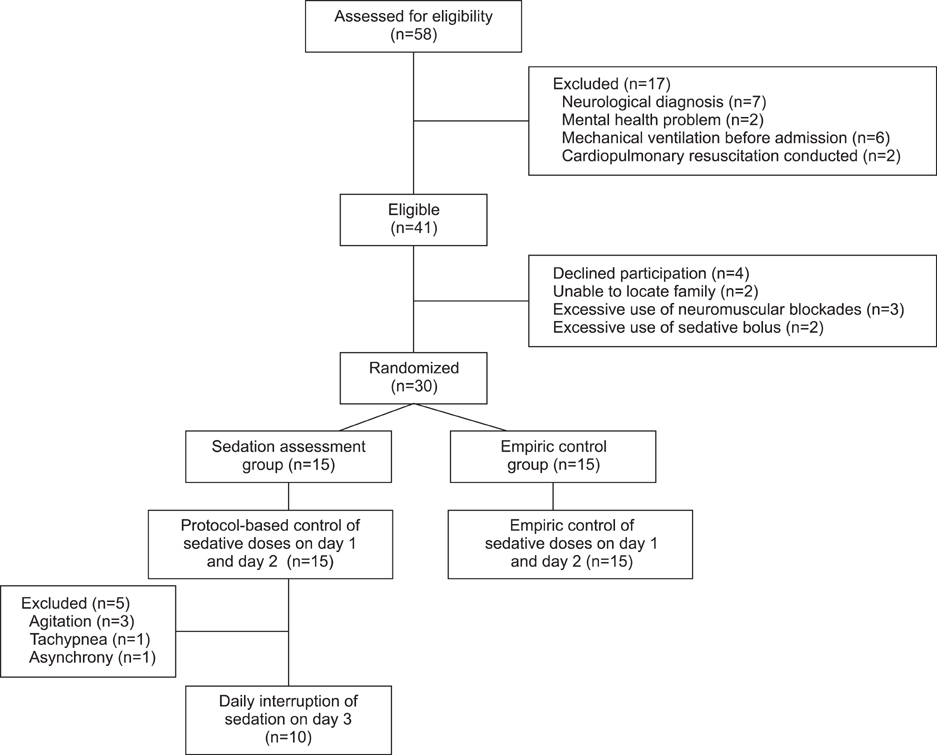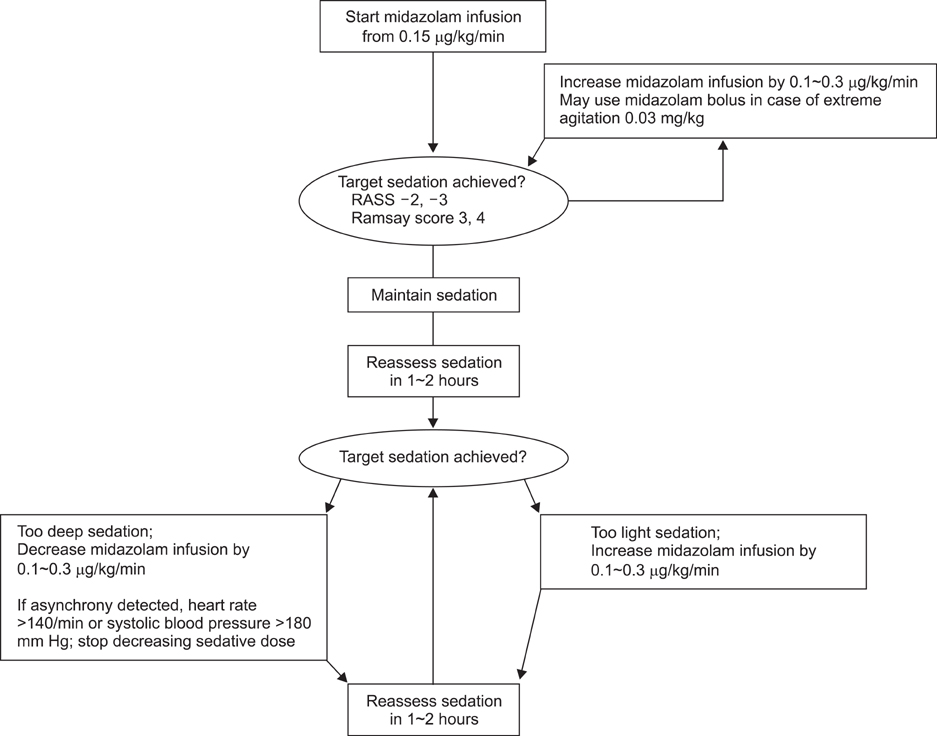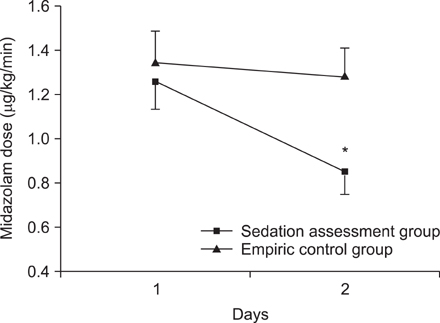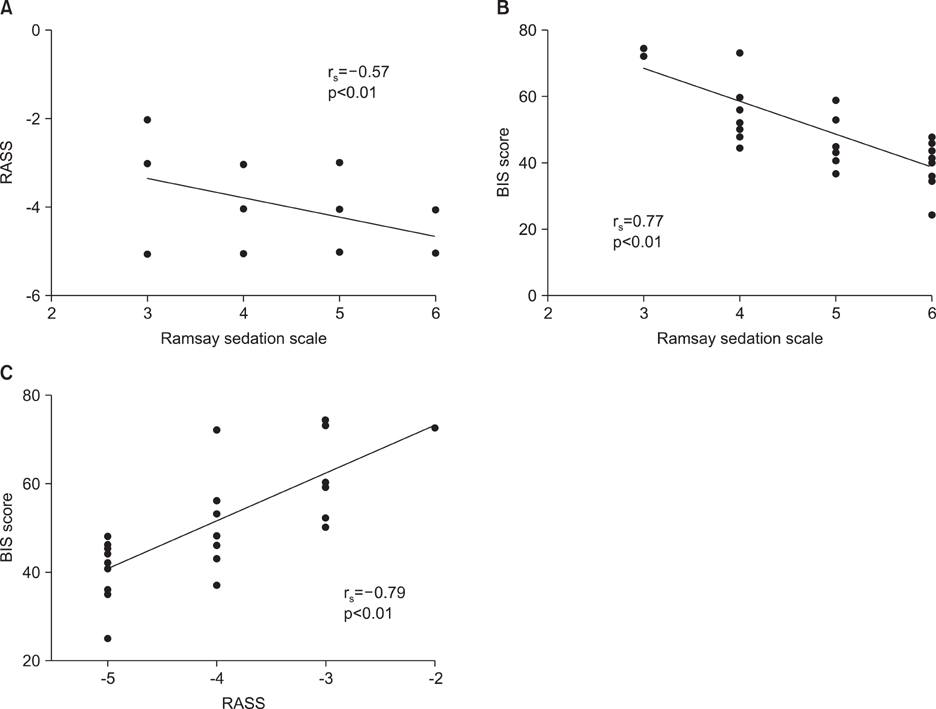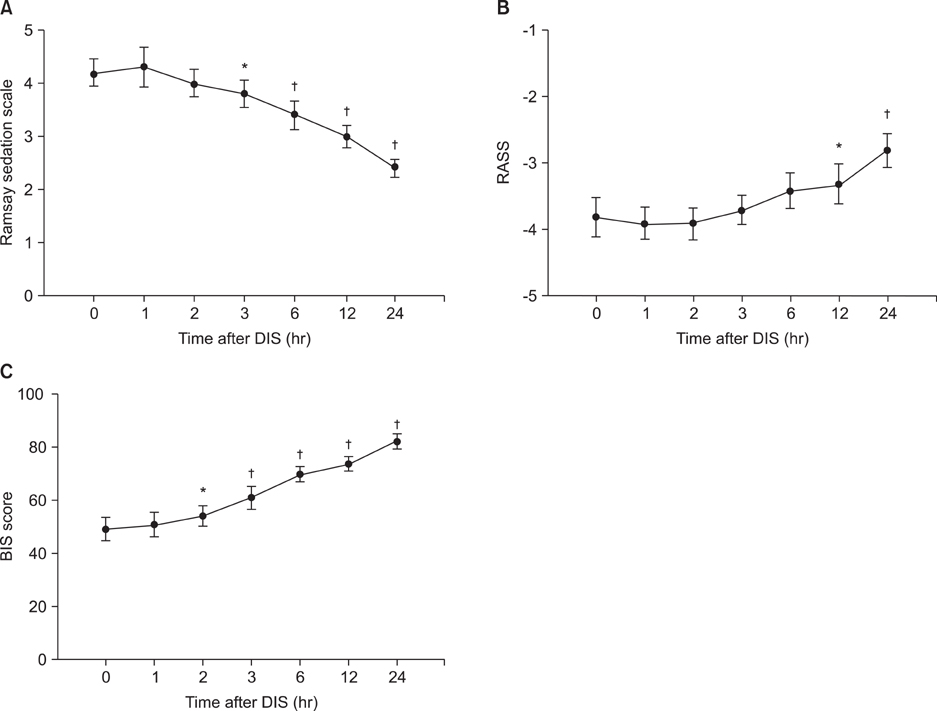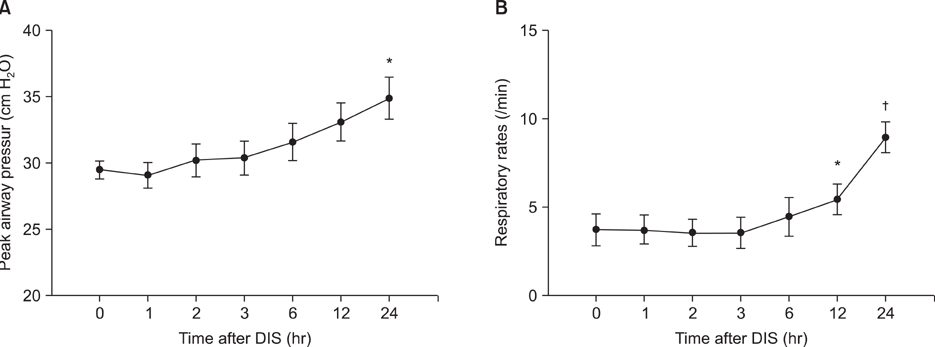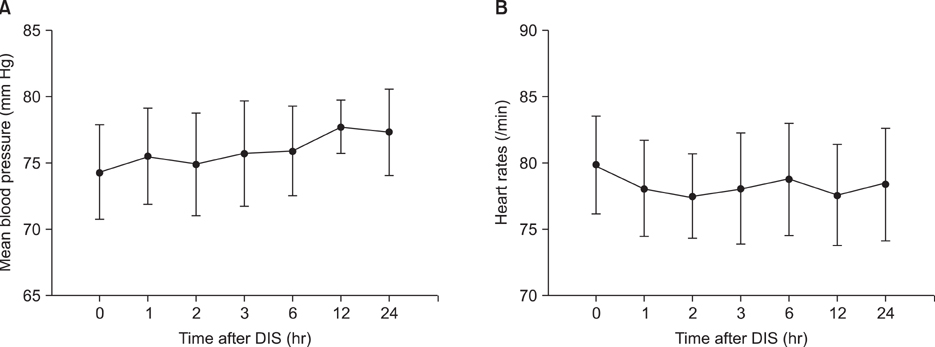Tuberc Respir Dis.
2012 Sep;73(3):151-161. 10.4046/trd.2012.73.3.151.
The Significance of Sedation Control in Patients Receiving Mechanical Ventilation
- Affiliations
-
- 1Department of Pulmonary and Critical Care Medicine, Ajou University School of Medicine, Suwon, Korea. parkkj@ajou.ac.kr
- KMID: 1842910
- DOI: http://doi.org/10.4046/trd.2012.73.3.151
Abstract
- BACKGROUND
Adequate assessment and control of sedation play crucial roles in the proper performance of mechanical ventilation.
METHODS
A total of 30 patients with various pulmonary diseases were prospectively enrolled. The study population was randomized into two groups. The sedation assessment group (SAG) received active protocol-based control of sedation, and in the empiric control group (ECG), the sedation levels were empirically adjusted. Subsequently, daily interruption of sedation (DIS) was conducted in the SAG.
RESULTS
In the SAG, the dose of midazolam was significantly reduced by control of sedation (day 1, 1.3+/-0.5 microg/kg/min; day 2, 0.9+/-0.4 microg/kg/min; p<0.01), and was significantly lower than the ECG on day 2 (p<0.01). Likewise, on day 2, sedation levels were significantly lower in the SAG than in the ECG. Significant relationship was found between Ramsay sedation scale and Richmond agitation-sedation scale (RASS; rs=-0.57), Ramsay Sedation Scale and Bispectral Index (BIS; rs=0.77), and RASS and BIS (rs=-0.79). In 10 patients, who didn't require re-sedation after DIS, BIS showed the earliest and most significant changes among the sedation scales. Ventilatory parameters showed significant but less prominent changes, and hemodynamic parameters didn't show significant changes. No seriously adverse events ensued after the implementation of DIS.
CONCLUSION
Active assessment and control of sedation significantly reduced the dosage of sedatives in patients receiving mechanical ventilation. DIS, conducted in limited cases, suggested its potential efficacy and tolerability.
Keyword
MeSH Terms
Figure
Reference
-
1. Jacobi J, Fraser GL, Coursin DB, Riker RR, Fontaine D, Wittbrodt ET, et al. Clinical practice guidelines for the sustained use of sedatives and analgesics in the critically ill adult. Crit Care. 2002. 30:119–141.2. Kollef MH, Levy NT, Ahrens TS, Schaiff R, Prentice D, Sherman G. The use of continuous i.v. sedation is associated with prolongation of mechanical ventilation. Chest. 1998. 114:541–548.3. Kaplan LJ, Bailey H. Bispectral index (BIS) monitoring of ICU patients on continuous infusion of sedatives and paralytics reduces sedative drug utilization and cost. Crit Care. 2000. 4:Suppl 1. P190.4. Payen JF, Chanques G, Mantz J, Hercule C, Auriant I, Leguillou JL, et al. Current practices in sedation and analgesia for mechanically ventilated critically ill patients: a prospective multicenter patient-based study. Anesthesiology. 2007. 106:687–695.5. Ramsay MA, Savege TM, Simpson BR, Goodwin R. Controlled sedation with alphaxalone-alphadolone. Br Med J. 1974. 2:656–659.6. Ely EW, Truman B, Shintani A, Thomason JW, Wheeler AP, Gordon S, et al. Monitoring sedation status over time in ICU patients: reliability and validity of the Richmond Agitation-Sedation Scale (RASS). JAMA. 2003. 289:2983–2991.7. Sessler CN, Gosnell MS, Grap MJ, Brophy GM, O'Neal PV, Keane KA, et al. The Richmond Agitation-Sedation Scale: validity and reliability in adult intensive care unit patients. Am J Respir Crit Care Med. 2002. 166:1338–1344.8. De Deyne C, Struys M, Decruyenaere J, Creupelandt J, Hoste E, Colardyn F. Use of continuous bispectral EEG monitoring to assess depth of sedation in ICU patients. Intensive Care Med. 1998. 24:1294–1298.9. Simmons LE, Riker RR, Prato BS, Fraser GL. Assessing sedation during intensive care unit mechanical ventilation with the Bispectral Index and the Sedation-Agitation Scale. Crit Care Med. 1999. 27:1499–1504.10. Kress JP, Pohlman AS, O'Connor MF, Hall JB. Daily interruption of sedative infusions in critically ill patients undergoing mechanical ventilation. N Engl J Med. 2000. 342:1471–1477.11. Schweickert WD, Gehlbach BK, Pohlman AS, Hall JB, Kress JP. Daily interruption of sedative infusions and complications of critical illness in mechanically ventilated patients. Crit Care Med. 2004. 32:1272–1276.12. Carson SS, Kress JP, Rodgers JE, Vinayak A, Campbell-Bright S, Levitt J, et al. A randomized trial of intermittent lorazepam versus propofol with daily interruption in mechanically ventilated patients. Crit Care Med. 2006. 34:1326–1332.13. Kress JP, Gehlbach B, Lacy M, Pliskin N, Pohlman AS, Hall JB. The long-term psychological effects of daily sedative interruption on critically ill patients. Am J Respir Crit Care Med. 2003. 168:1457–1461.14. Kress JP, Vinayak AG, Levitt J, Schweickert WD, Gehlbach BK, Zimmerman F, et al. Daily sedative interruption in mechanically ventilated patients at risk for coronary artery disease. Crit Care Med. 2007. 35:365–371.15. Payen JF, Bru O, Bosson JL, Lagrasta A, Novel E, Deschaux I, et al. Assessing pain in critically ill sedated patients by using a behavioral pain scale. Crit Care Med. 2001. 29:2258–2263.16. Kress JP, O'Connor MF, Pohlman AS, Olson D, Lavoie A, Toledano A, et al. Sedation of critically ill patients during mechanical ventilation: a comparison of propofol and midazolam. Am J Respir Crit Care Med. 1996. 153:1012–1018.17. Bucknall TK, Manias E, Presneill JJ. A randomized trial of protocol-directed sedation management for mechanical ventilation in an Australian intensive care unit. Crit Care Med. 2008. 36:1444–1450.18. Marshall J, Finn CA, Theodore AC. Impact of a clinical pharmacist-enforced intensive care unit sedation protocol on duration of mechanical ventilation and hospital stay. Crit Care Med. 2008. 36:427–433.19. Mondello E, Siliotti R, Noto G, Cuzzocrea E, Scollo G, Trimarchi G, et al. Bispectral Index in ICU: correlation with Ramsay Score on assessment of sedation level. J Clin Monit Comput. 2002. 17:271–277.20. Karamchandani K, Rewari V, Trikha A, Batra RK. Bispectral index correlates well with Richmond agitation sedation scale in mechanically ventilated critically ill patients. J Anesth. 2010. 24:394–398.21. Girard TD, Kress JP, Fuchs BD, Thomason JW, Schweickert WD, Pun BT, et al. Efficacy and safety of a paired sedation and ventilator weaning protocol for mechanically ventilated patients in intensive care (Awakening and Breathing Controlled trial): a randomised controlled trial. Lancet. 2008. 371:126–134.
- Full Text Links
- Actions
-
Cited
- CITED
-
- Close
- Share
- Similar articles
-
- Comparison of Propofol and Midazolam for Sedation of Mechanically Ventilated Patients
- The Efficacy of the COMFORT Scale in Assessing Optimal Sedation in Critically Ill Children Requiring Mechanical Ventilation
- Sedation in the Critically Ill Patients
- The Comparative Study of Central Venous Pressure Measurements during Mechanical Ventilation and after Disconnection of Ventilation
- Respiratory Review of 2013: Critical Care Medicine

